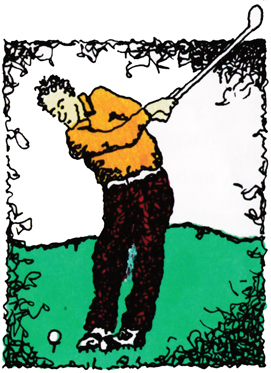Golf is an Approach Shot Game
 The title of this article goes against much of what conventional thinking says about success in golf. Most teachers and students are under the impression that the short game is the most important phase of the game, while others might say the ability to drive the ball long and straight is. Some will say it is putting, since research shows putts make up about 43 percent of all strokes taken. I want to make the case that the approach shot is actually the most important shot on any given hole for golfers who can break 100.
The title of this article goes against much of what conventional thinking says about success in golf. Most teachers and students are under the impression that the short game is the most important phase of the game, while others might say the ability to drive the ball long and straight is. Some will say it is putting, since research shows putts make up about 43 percent of all strokes taken. I want to make the case that the approach shot is actually the most important shot on any given hole for golfers who can break 100.
My first bit of evidence is incredibly strong – a study published twice over the years in Golf Digest magazine. The study shows that a person’s average score is very closely tied to the average number of greens hit in regulation. For a particular number of greens hit in regulation on average, a person’s score will be within a range of four shots – no more and no less.
For example, the study showed that a person who averages three GIR will average between 87 and 91. Almost no one who averages three GIR will average more or less than this scoring range. This means that the person who averages three GIR and has a lousy short game will average 91, while the golfer who has a great
short game will average 87. Now, four shots is a significant difference and should not be ignored. The short game is indeed important. However, golfers who want to go from averaging 89 to 80 must improve their ballstriking.
Unfortunately, too many teachers are under the belief that bogey golfers can shoot 80 if they can just improve their short game. This is simply not the case. To average 80, a golfer must hit at least 6.5 GIR on average, and that is with a great short game. Most who average 80 will average around 7.5 GIR, according to the study.
I apologize if all of these numbers make your head spin, but they are important in illustrating my point. I also did a study of my own a number of years ago, using an amateur tour in Florida that confirmed these findings. Of the statistics the tour kept, my study back then showed that GIR was the most highly-correlated statistic in relation to scoring average, followed in order by driving accuracy, sand save percentage, putting, and driving distance.
The problem with all of this, of course, is that hitting accurate iron approaches is a very difficult prospect for many golfers. It is perhaps for this reason many teachers urge their students to focus on the short game, because these teachers believe their students can excel at the short game with some practice and correct technique. These teachers also say that, since their students will miss the majority of greens in regulation, it is important to have a good short game to save strokes.
These reasons have some validity, but they still don’t overcome the fact that improving the short game can only produce a maximum improvement of four strokes – and that’s only if the student has a lousy short game in the first place. If their short game is average for their skill level, maximum improvement through the short game alone can now only be two strokes.
(To clarify – as I pointed out earlier, this is for golfers who can break 100. For those who can’t, they will probably lose more than four strokes around the greens. I don’t want anyone to get the impression I think working on the short game is unimportant. It certainly is, for all skill levels. My goal with this article is to just put it into proper context.)
Beyond statistics, let’s look at some practical matters beyond the number of GIR, because we might have some students who can’t reach greens in regulation. For them, the first shot within range of the green becomes all important. Whether the shot is to hit a green in regulation or not, putting the approach shot on the green nor – mally means the golfer is only going to take two more shots at most. Missing the green normally means two more shots at the minimum.
How can we get our students to hit better approach shots? First, check their equipment. Game improvement irons abound, with perimeter weighting and low centers of gravity. Don’t overlook the shaft, either. Dynamic Gold shafts have high kick points, meaning lower ball flights and less spin. Softer-tipped shafts, such as Dynalite Gold, TX-90, and many graphite shafts help get the ball airborne with more spin. Some companies are making what basically amounts to a whole set of hybrid irons, for hitting approach shots with even greater ease. Many golfers also have lie angles in their irons that aren’t right for their swings.
Technique-wise, of course, most of our students are lacking. Standard teaching would apply here.
Strategically, our students should know that they should not try to shoot at every pin. For example, if the pin is on the left-hand side of the green, left-to-right players should just aim at the flag and let the ball drift to the right. Pin positions in the center or on the right side are okay to attack. Also, many golfers simply don’t use enough club. Get your students to use an approach club based on average, not maximum, distance.
In conclusion, other areas of the game should not be neglected. They are of obvious importance. But to get students to lower their scores permanently, they must hit more greens. It’s hard work, but it can be done – and must be done for permanent improvement.




